Are you planning to grow an Anthurium clarinervium in your home and are wondering how to take care of it? Here’s a full Anthurium clarinervium care guide for you!
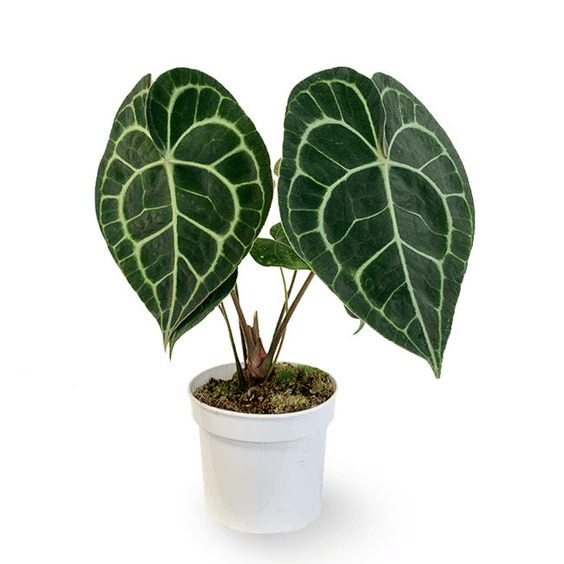
Source: Pinterest
Thank you for reading this post, don't forget to the best blogger Guy About Home who offers the best garden and home improvement tips! If you are a home decor and design fan, don't miss the tips on home ideas. If you are a home garden owner, then you might be interest in our complete guides to house plants!
Anthurium clarinervium makes a stunning houseplant with its breathtaking thick foliage. It has unique, large, heart-shaped leaves with mesmerizing vein patterns that can make anyone stop in their tracks. This is why it is becoming popular among collectors of houseplants.
Moreover, if you want to add a Mexican tropical feel to your home, this plant would be your perfect choice. However, we do not recommend it to newbie growers because it is a very sensitive plant that really needs special care. But no need to worry because we are here to help you grow a healthy Anthurium clarinervium plant through this guide. So read on!
Not confident in planting an indoor plant? Why not getting power from our inspiring indoor plants quotes?
What Is Anthurium Clarinervium
Latin Name: Anthurium Clarinervium
Common Names:
-
- Velvet Cardboard Anthurium
- Anthurium
- Giant laceleaf
- White-veined Clarinervium
This plant was called the Velvet Cardboard Anthurium because of its thick and velvety leaves which gave the plant its beauty. It is an epiphyte so it grows on another plant’s surface instead of on the ground. It collects moisture and nutrients from its surroundings like from fallen debris, rain, and air. Plus, it consists of more than 1,000 different species.
They look alien and usually have elaborate leaves and strange flowers. They are found in tropical forests in the Caribbean, Mexico, and South America.
Anthurium Clarinervium Size and Growth
The size and growth of Anthurium clarinervium plants depend on the species as well as the environment. On average, they can grow from 15 to 25 inches in height and can spread from 20 to 40 inches. On the other hand, their leaves can grow from 5 to 12 inches long and their unique flowers can grow up to about three inches.
Moreover, this plant has a slow growth rate that you only need to repot it every two to three years. But, they can grow faster in optimal conditions.
No worries! Though you might encounter the difficulties when learning how to care such an plant as a new plant caring starter, we got the most popular plant lover quotes that can partner with you and you are going to succeed in plant care and grow.
Features of Anthurium Clarinervium
Below are the key features of Anthurium clarinervium:
Flowers
- Anthurium clarinervium blooms are not as pretty as other Anthurium varieties
- Small and seasonal blooms
- Pinkish white in color
- They don’t have petals
- They look like bright-colored leaves with a glossy shine and velvety texture
- You can only see them if you keep your anthurium healthy
- They grow from three to four inches
Leaves
- Big, dark-green, heart-shaped leaves that are leathery
- Evergreen velvety leaves
- Light-green underside
- They feature prominent white veins
Fruit
Turns orange on maturity
Benefits of Anthurium Clarinervium
Growing this plant gives you the following benefits:
- It can be easy to maintain and grow
- Its large leaves with creamy-white veins are eye-catching
- They make great displays
Toxicity
The plant is toxic to both humans and pets because all parts contain Calcium Oxalate crystals. It causes ulceration in your esophagus and throat as well as heart problems when ingested. Make sure to keep your kids and pets away from the plant.
Other Types of Anthuriums You Can Choose From
Aside from Anthurium clarinervium, there are other types of Anthuriums that you can also try. Below are some of the most popular ones along with their key features:
#1 Anthurium pachyneurium
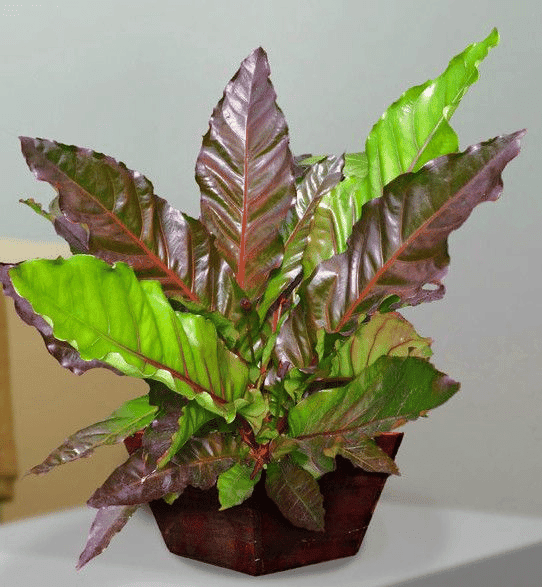
Source: Pinterest
- Also called Big Red Bird
- Leaves grow upward rather than downward
- Rosette growth habit
- Turns red in bright light
- Long leaves with zig-zag patterns around their edges
- Deeply rooted stems
#2 Anthurium warocqueanum
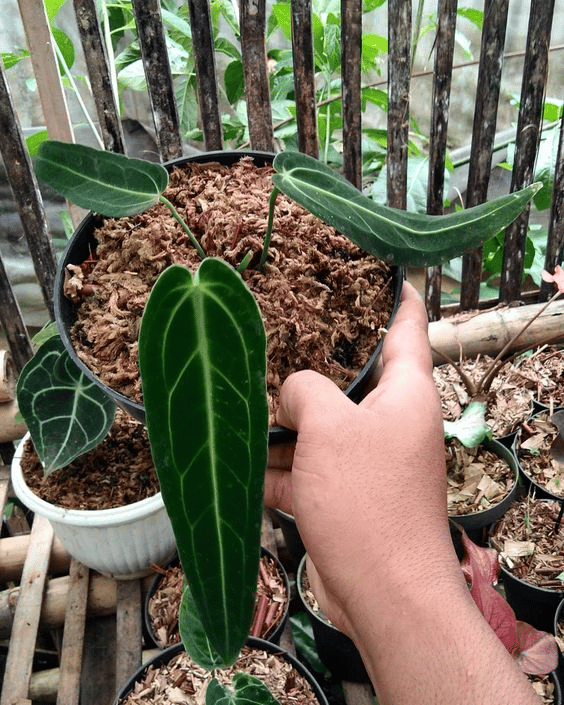
Source: Pinterest
- Also called Queen Anthurium
- Long narrow velvety leaves that can grow up to six feet
- White to silver veins
- Known for its attractive foliage
#3 Anthurium watermaliense
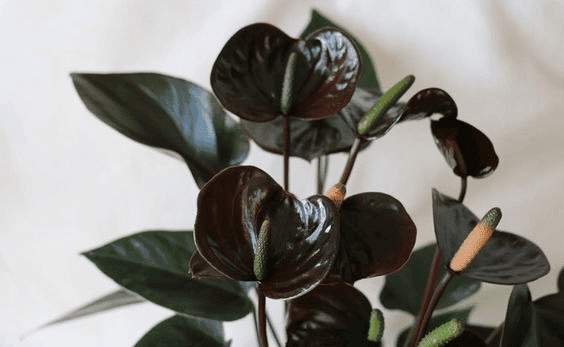
Source: Pinterest
- Also called Black Anthurium
- Deep purple flowers that look black
- Dark-green leaves
#4 Anthurium magnificum
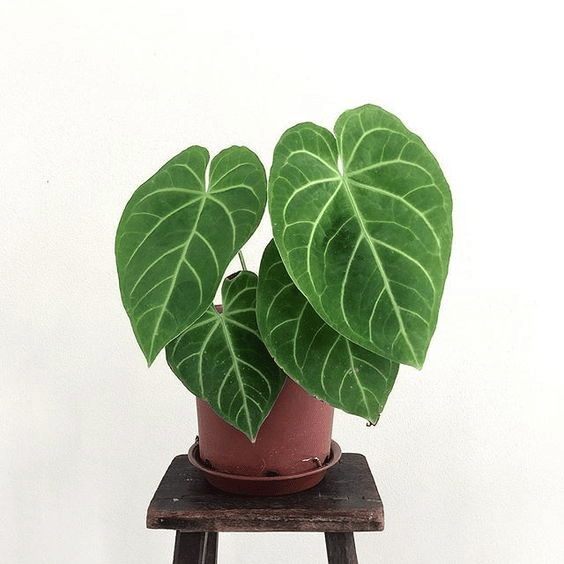
Source: Pinterest
- Big round leaves
- Heavily veined green leaves
- Red flowers
- Quadrangular petioles
#5 Anthurium veitchii
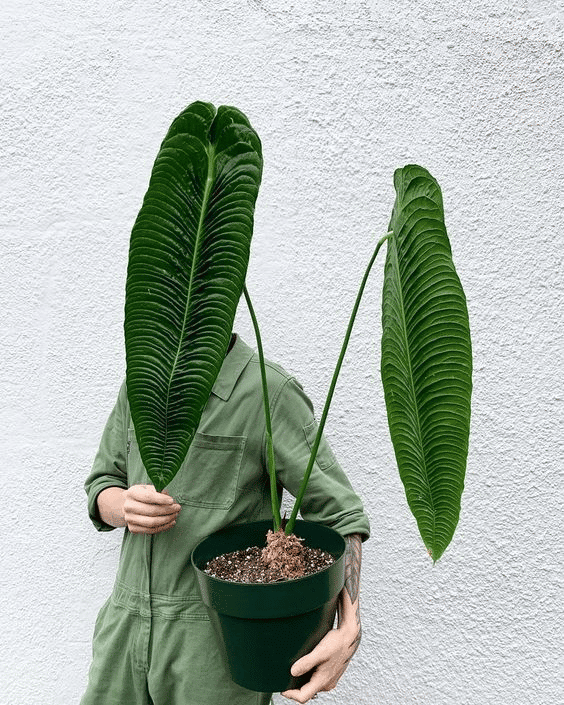
Source: Pinterest
- Also called King Anthurium
- Large plants (leaves can reach up to four feet)
- Greenish white and leathery flower spikes
- Cream-colored spadix
#6 Anthurium scandens
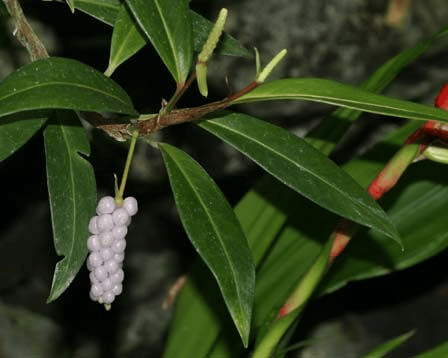
Source: Pinterest
- Also called Pearl Laceleaf
- Climbing plant
- Small leaves that grow up to five inches
- Yellow-green spathe
- Produces ornamental berries
#7 Anthurium andraeanum
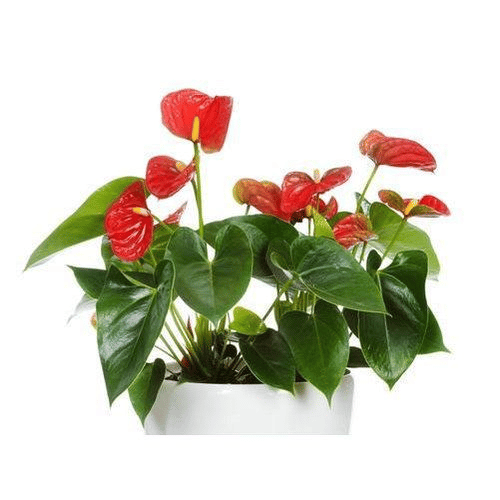
Source: Pinterest
- Also called Painter’s Palette or Flamingo Lily
- Waxy heart-shaped pink leaves
- Cream-yellow tail-like spadix
- Waxy red spathe
How to Propagate Anthurium Clarinervium
There are two methods you can choose from to propagate your plant: Anthurium clarinervium cuttings or root division. Below, we provided a step-by-step guide for each method so that you will know which one is easier to do for you:
Besides this plant, we also make a full care guide on how to propagate Epipremnum Pinnatum-Care.
Stem Cuttings
1. First of all, you need to obtain stem cuttings from your plant. It is better to cut from new growth or you can obtain the cuttings when you are pruning your plant. Make sure that the cuttings are at least two to four inches long with two leaves. Also, always cut above a leaf node.
2. After that, you can either do water propagation or cure the stem cutting before planting it:
Water Propagation
-
- Place the cuttings in a jar filled with water until they produce roots that are at least one inch long
Curing the Stem
-
- Curing allows the formation of a callous end to promote healthy growth. To cure your stem cutting, lay it in a warm room (not hot) for 5 to 7 days.
3. Plant the stem cutting in a self-draining pot. Keep the soil moist until your plant starts growing and make sure that it gets enough lighting. Follow the plant care tips we have mentioned in the last section of this blog.
Root Division
- Carefully pull your Anthurium out of the soil on its pot to avoid damaging its roots.
- Rinse the roots to remove the soil using gentle running water.
- Once the roots are clean, gently pull some roots apart to divide the plant.
- Allow the divided roots to dry for at least 12 hours by laying them on a clean paper towel.
- After the roots have dried, plant them using the recommended potting soil. Make sure the roots are fully immersed in the soil.
Common Anthurium Clarinervium Diseases/Problems
The plant is easy to grow. But because of its specific potting and humidity requirements, it can be affected by various diseases if not cared for correctly. Below are the common problems that you might encounter with Anthurium Clarinervium plants:
Besides this plant, we also summarize the caring issues and concerns on the plant Cereus Repandus.
#1 Root Rot
- Possible causes might be overwatering and humid conditions
- Use a well-draining potting mix to avoid root rot
- Try to trim off diseased roots and repot your plant
- You can also propagate the remaining healthy roots to save your plant if the root rot is worse than expected
#2 Pest Infestation
- Since the plant needs high humidity to live, it attracts pests like spider mites, mealybugs, scale, and aphids
- Spray your plant with insecticidal soap to control the pests
#3 Yellow Leaves
- The common causes are overwatering, root rot, and not enough sunlight
- Other symptoms include droopy plant stems
- Control your watering schedule and place your plant in a bright location
#4 Brown Leaf Edges
- Common causes are lack of humidity and too much direct sunlight which leads to leaf scorch
- The only solution is to add humidity through regular misting or using a humidifier (we will discuss more on this in the Anthurium clarinervium plant care tips section)
#5 Stopped Growing
- Your plant will grow slowly and look like it stopped growing if it is not receiving enough light and its environment is dry
- Move your Anthurium to a brighter location (do not expose your plant under direct sunlight)
- Daily misting and putting the pot on a pebble tray can also help increase humidity
#6 Dull Foliage
- Again, not enough light can cause your plant to have dull veins and leaves. Without enough light, your plant cannot undergo the photosynthesis process to produce its needed nutrition
- Follow the recommended lighting tips in the next section to fix a dull Anthurium foliage
Anthurium Clarinervium Plant Care Tips
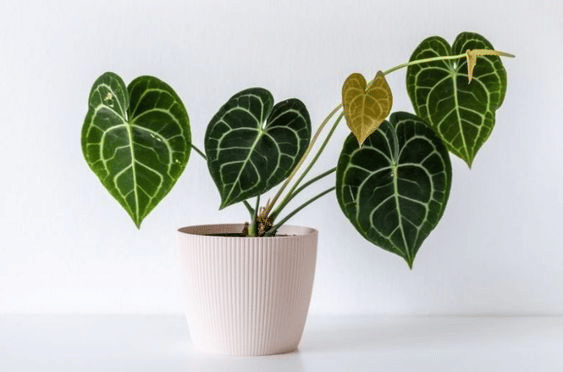
Source: Pinterest
When you are growing a tropical plant as a houseplant, you have to mimic its natural habitat so it can thrive the way you want it to. As we’ve said earlier, Anthurium clarinervium is a very sensitive plant with special living requirements. If you want your plant to grow healthy, follow the tips we provided below:
Besides this plant, we also make a full care guide on how to care for Cattleya Trianae.
Soil
Let’s start with the Anthurium clarinervium potting mix. First of all, the soil must be well-draining because this plant needs quick drainage to avoid root rot. You can check if the soil mix is well-draining beforehand. Just pour water on it while it is in the pot and observe how fast the water is draining through it.
For the recommended potting mix, orchid bark soil mixes would be the best. The key ingredients for this potting mix recipe are sphagnum moss, perlite, and Douglas fir bark. However, make sure that there is more sphagnum moss and perlite compared to the bark. The ideal ratio is 5:1. Lastly, the acidity of the soil should range from 5.5 pH to 6.5 pH.
Lighting
For Anthurium clarinervium lighting, here are the tips you can follow:
- The plant thrives in medium-light conditions
- Avoid direct sunlight because it can scorch and burn your plant. The plant has a high sensitivity to heat and the sun.
- Stick to east or north-facing windows and avoid west or south-facing windows
Watering
Remember that Anthurium clarinervium roots are exposed because they are epiphyte plants. The exposed roots will dry out faster compared to other plant roots, especially during warm seasons. It is better to water your plant around three times per week during these times.
However, do not overwater your plant as it can lead to root rot and cause your plant to die. Only water your plant if the first two soil layers are dry. Always make sure that you use a self-draining pot for your plant too.
Moreover, keep the soil moist during the growing season (March to September). You don’t have to water the plant that much in the dormant seasons and in colder months because the soil can retain water easier in these times. Only water your plant two times a month during the dormant seasons.
Temperature
The plant has different temperature requirements depending on the season. In the growing season, the ideal temperature range for optimal growth is between 64°F (18°C) and 70°F (21°C). The plant can also tolerate temperature ranges from 54°F (12°C) to 85°F (29°C).
Humidity
These plants thrive and grow faster in very humid conditions. Their leaves will also become greener and brighter in high humidity. The optimal humidity is around 80% but 60% is good enough.
There are two ways you can do to increase humidity in the plant’s environment:
- Use a humidifier
- Use a pebble tray
If you don’t have enough budget, you can use create a pebble tray for your plant:
- Fill the tray with pebbles
- Add water but do not add too much that the water is already covering the pebbles
- Place your plant’s pot on the pebble tray
The water evaporating from the pebble tray will create humidity that will go straight to the plant.

Source: Pinterest
Fertilizing
Use half-strength Anthurium clarinervium fertilizer with a high phosphorus content. The phosphorus should have the highest amount compared to all other elements in the fertilizer. This plant doesn’t need to be fertilized often. You only need to fertilize it every two months in its growing season and once a month in the winter months.
Moreover, you need to flush the soil of your plant every three to four months to prevent the buildup of mineral salt. This is a common issue with Anthurium clarinervium plants. To flush the soil, you just need to run water through it for at least three minutes.
Repotting
Repotting Anthurium clarinervium plants is as easy as repotting any other houseplant. These plants have a slow growth rate. Thus, you only need to repot them every two to three years, especially if they are already outgrowing their current pot. Also, the best time to report is during springtime.
In ideal living conditions, your plant can grow quickly and develop strong stems as well as broad leaves. So it is recommended to check your plant regularly to make sure that its pot still has enough space to make room for new growth. Or else, your plant might become stunted.
Here are the signs that can tell you if it’s time to repot your plant:
- If your plant is already too big for its pot
- If you can see roots in the pot’s topsoil
- If the plant’s roots are growing outside the pot’s drainage holes
Pruning
Occasional pruning encourages vigorous growth and helps in improving your plant’s appearance. You can snip off dead, diseased, or faded foliage, as well as leggy stems, every once in a while to help your plant grow better. We recommend pruning your plant in the spring before its growing season. Also, since the flowers are not aesthetically appealing, Anthurium clarinervium flower cutting is recommended to allow your plant to concentrate on producing new growth.
Also Read:
- A Full How-to Guide for Cebu Blue Pothos Care
- A Full How-to Guide for Crispy Wave Fern Care
- A Full How-to Guide for Manjula Pothos Care
- A Full How-to Guide for Monkey Face Orchid Care
- How To Take Care Of Succulents
- The Ultimate Guide to Growing Tomatoes
- Your Complete Guide on How to Grow Potatoes – Everything You Need to Know
For more step-by-step ideas, diy tips and guides, kindly visit the website guyabouthome.com providing the best garden & home improvement tips.



